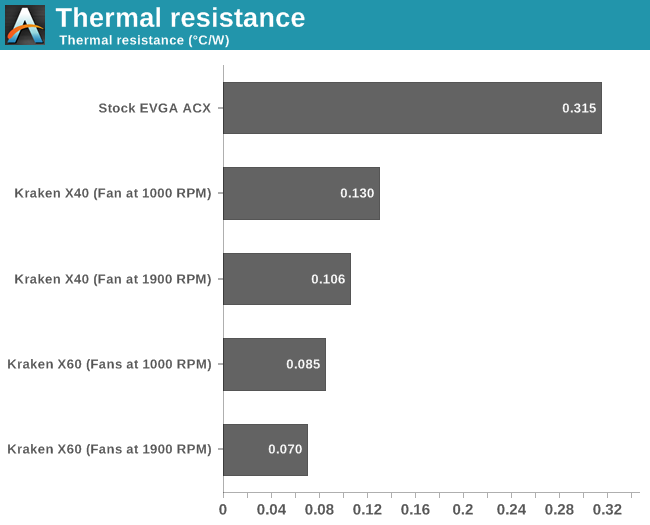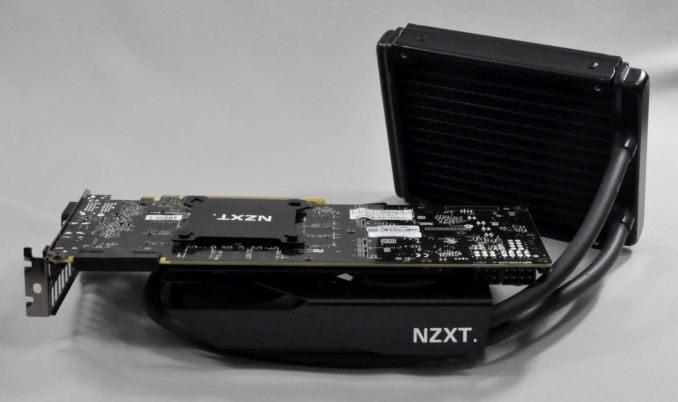NZXT Kraken G10 Review: Liquid Cooling for Your GPU
by E. Fylladitakis on March 11, 2014 1:15 AM EST- Posted in
- Cases/Cooling/PSUs
- NZXT
- Water Cooling
- Kraken
- G10
Performance Results
In order to assess the potential of the Kraken G10, we tested it on an EVGA GTX 770 ACX, a high performance graphics card with a good stock air-cooling solution. Testing is performed with the two cooling kits NZXT currently offers, the Kraken X40 (single 140mm) and the Kraken X60 (dual 140mm). In order to stress the GPU core to the maximum, we ran a cryptocoin mining algorithm at maximum intensity and allocation, a method that displayed considerably greater power draw (224W) than any 3D benchmark (≈174W during a Unigine Heaven run). It has the added benefit of being rather consistent in it's load.


NZXT claims that the Kraken G10 can yield up to a 40% increase in performance (cooling), which isn't phrased quite right. The actual performance difference of cooling solutions is properly calculated by comparing the °C/W performance ratings, not just by comparing temperatures. While saying, "80°C to 45°C – oh, that's 44% lower temperatures" is factually correct, it doesn't account for the power element and since temperature (Celsius) is not zero based, there are (many) problems with only looking at temperatures. More properly, a 50% reduction in the temperature change over ambient would equate to a 100% increase in cooling performance, and a 100% reduction in temperature change over ambient would mean driving the equipment at below ambient temperatures, which is obviously impossible without specialized cooling (e.g. thermoelectric coolers).
According to our performance testing shown in the charts above, the stock cooler has a performance rating of about 0.315 °C/W, which is a good rating for a stock air-cooler. However, even the worst result for the G10, that of using a Kraken X40 with the fan at 1000RPM, displays a performance rating of 0.13 °C/W. In that case, the thermal performance is over 58% lower. The best performing configuration we tested, that of a Kraken X60 with its fans at maximum speed, has a performance rating of about 0.07 °C/W, a 77% reduction in thermal resistance over the stock cooler. Put another way, the stock cooler has thermal resistance that's 350% higher (worse) than the X60 with fans at 1900RPM – impressive!
Conclusion
Being nothing more than a steel bracket, the Kraken G10 essentially is a very simple product, yet it displays tremendous potential. One can wonder why no one else thought of this before (or at least, no one released a product like this until now), as Asetek's kits have been available for years. A liquid-cooling kit, even with its fan running at minimum speed, offers immensely better thermal performance than the stock air-coolers of modern graphics cards. This is especially good news for users that are trying to build low noise systems, as the stock coolers of high performance graphics cards are often difficult to deal with.
However, as convenient as the Kraken G10 may appear, there are some obvious limitations. One such limitation is that the fans of the liquid-cooling kit cannot be thermally controlled in relation to the temperatures of the graphics card. When installing such a kit on the CPU, the fans can be thermally controlled by the motherboard, but that's not an option here. Although fan control is partially possible for the kits with USB interfaces, such as the Kraken X40/X60 that were used for this review, this control is limited to the predefined settings of the user and does not adjust automatically depending on the load of the card.
Furthermore, even though the included 92mm fan takes care of the problem, liquid-cooling is limited to the GPU core alone. Custom liquid-cooling kits can implement the use of full coverage cooling blocks, cooling the entire card rather than just the GPU; however, even if we neglect all other disadvantages that custom liquid-cooling setups have, a single such block usually costs more than an entire closed-loop kit plus the Kraken G10 bracket.
Finally, in order to be useful you need a case with a radiator mounting point near the card itself, such as at the bottom of the case or on the HDDs cage(s), as the hoses of typical closed-loop are limited in length. It is unlikely that the radiator will reach the top or front panel in all but the smallest of cases, and multiple graphics card setups will only be possible in specific case designs.
Despite these limitations however, the NZXT Kraken G10 remains a very appealing product. NZXT took the simplest of ideas, carried it through to fruition, and brought it to the market as a $30 USD product that (currently) has zero competition. It is a product that we would highly recommend to anyone who has a proper case and wants better cooling for a high-end graphics card without the cost and complexity of a customized water cooling kit.











61 Comments
View All Comments
Nirvanaosc - Tuesday, March 11, 2014 - link
... the fan speed / temperature curve. Just perfect.I have it controlling 8 fans + 2 pumps (6 GPU and + pump and 2 CPU + pump) in 3 PWM channels.
Streetwind - Tuesday, March 11, 2014 - link
You claim that there is currently no competing product, but what about Arctic Cooling's Accelero Hybrid cooler? True, it's not just a bracket, but rather a complete solution. But still, it does the same thing, cooling the GPU with a closed water loop and the other onboard components with a small dedicated fan. It's been on the market since summer 2012.Overall though, I like the flexibility the mounting bracket offers. Users can pick and choose the liquid loop they want or need for their card and/or goals, which is important considering how much the various solutions differ in terms of price, noise and performance. And in general, I think that closed liquid loops are horribly overpriced and overspecced for CPU cooling without showing any real advantage over air solutions, whereas on a GPU their high potential can actually be utilized (as the temperature results in this test show).
Now if we could just get an Asetek pump unit that was truly quiet in idle mode, even I might start to show genuine interest... ;)
SquattingDog - Tuesday, March 11, 2014 - link
Any chance of testing additional cards, such as the 7970/280X as these require "shims" which do not appear to be included in the kit?! Also other higher power cards such as 780GTX, 290 and 290X would be great to see how it performs with them.Folterknecht - Tuesday, March 11, 2014 - link
http://www.tomshardware.de/r9-290-umbau-wasserkuhl...BlakKW - Tuesday, March 11, 2014 - link
In terms of what I might spend money on in the near-future, this is the most interesting mini-review + comments that I've seen on AT in long time... tyGigaplex - Tuesday, March 11, 2014 - link
"While saying, "80 °C to 45 °C – oh, that's 44% lower temperatures" is technically correct"No, it's not even technically correct. When comparing temperatures like this, you need to either measure the delta from ambient (sensible) or measure from absolute zero (less sensible). 45 °C is not 56% of 80 °C, convert to Fahrenheit and try to make the same claim.
JarredWalton - Tuesday, March 11, 2014 - link
Of course it's "technically correct", meaning that the temperature dropped 45C. But as we go on to explain, that's not really looking the right aspect. It's like arguing that saying "the sun is shining" isn't "technically correct" because if we get into the nitty gritty details, "shining" isn't really the right word. Good grief! There are all sorts of reasons to not simply compare temperatures, which is why E. uses the more useful C/W and explains why it's more useful.JarredWalton - Tuesday, March 11, 2014 - link
Maybe we should switch to Kelvin though? LOLRick83 - Wednesday, March 12, 2014 - link
It's not technically correct, and NZXT should be called out for spouting such ridiculous marketing rubbish.It's just as incorrect as 4 inches being twice as long as 3 inches, because 0 inch celsius is equal to 2 inches. You cannot use linear scaling with fixed offset units. Doing so to get impressive marketing numbers is misleading, and should be punished. I for one will avoid NZXT, thanks to this ludicrous display of marketing mistakes, where the engineers weren't asked to proofread wild marketing claims.
E.Fyll - Tuesday, March 11, 2014 - link
You are correct. Unfortunately my original text was phrased in a rather, um, "insensitive" manner, and thus an editor rightfully felt that he had to edit it. It is my fault, as I need to be more careful of how I phrase certain things.True enough, it is not technically correct. It just is not correct at all, in any way possible. :)